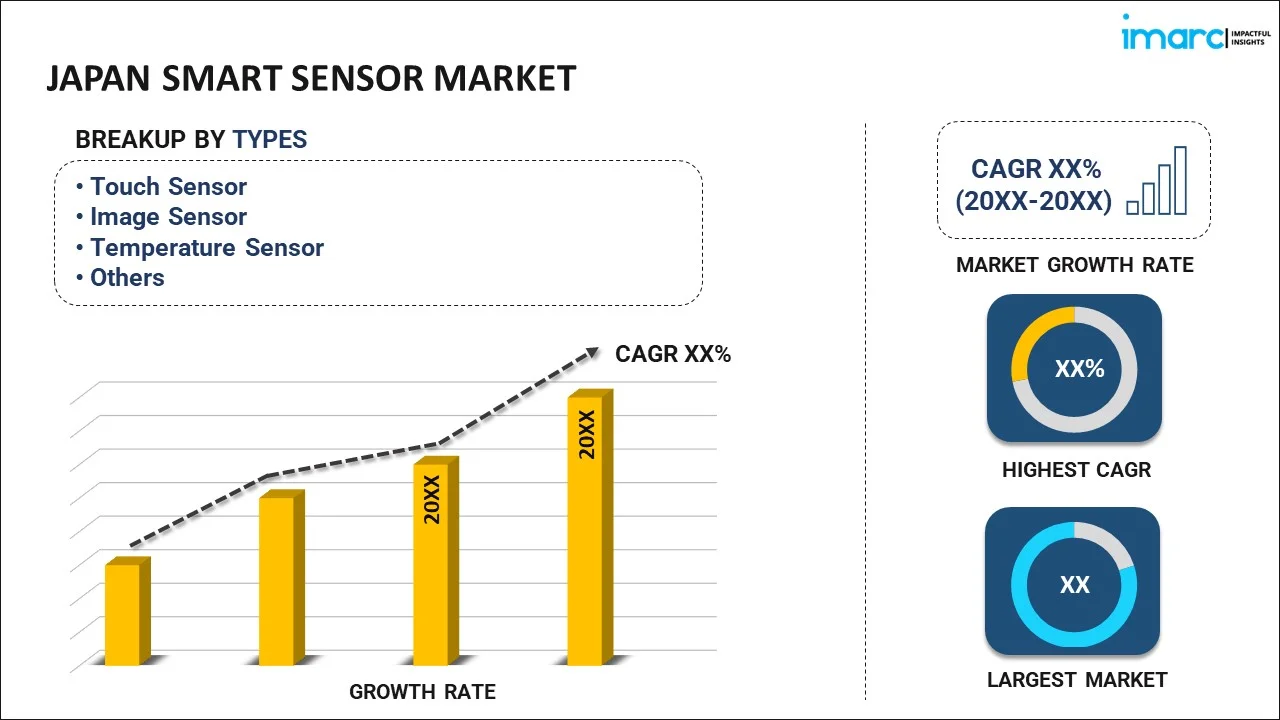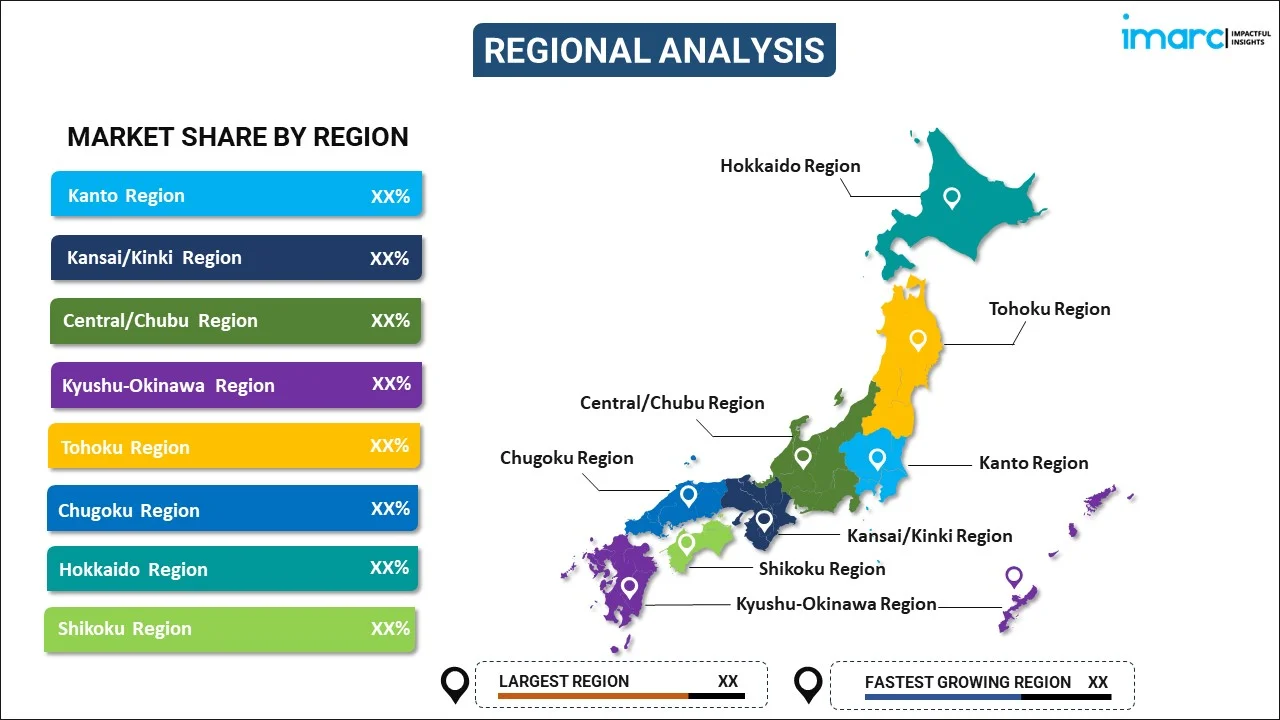
Japan Smart Sensor Market Report by Type (Touch Sensor, Image Sensor, Temperature Sensor, Motion Sensor, Position Sensor, Pressure Sensor), End User (Automotive, Consumer Electronics, Infrastructure, Healthcare, and Others), and Region 2025-2033
Market Overview:
Japan smart sensor market size reached USD 4.8 Billion in 2024. Looking forward, IMARC Group expects the market to reach USD 119.9 Billion by 2033, exhibiting a growth rate (CAGR) of 43% during 2025-2033. The increasing demand for cloud services and big data analytics, the rising need for more reliable and scalable data processing and storage facilities and stringent regulatory compliance represent some of the key factors driving the market.
|
Report Attribute
|
Key Statistics
|
|---|---|
|
Base Year
|
2024 |
|
Forecast Years
|
2025-2033 |
|
Historical Years
|
2019-2024
|
| Market Size in 2024 | USD 4.8 Billion |
| Market Forecast in 2033 | USD 119.9 Billion |
| Market Growth Rate (2025-2033) | 43% |
A smart sensor is an electronic device designed to receive environmental inputs and execute predefined tasks using its built-in computing resources. It converts these inputs into measurable electrical signals, which are then processed by microcontrollers, transceivers, and amplifiers to perform the required functions. Smart sensors are seamlessly integrated with the Internet of Things (IoT) and serve various measurement purposes, including temperature, mass, speed, pressure, and heat. Among the commonly available smart sensors are touch, image, temperature, motion, pressure, and position sensors, which find applications in configuring, verifying, and communicating information. They offer advanced features like self-calibration, support for cloud connectivity, and multiple sensing and computational capabilities. Consequently, they enjoy widespread use across industries such as healthcare, defense, electronics, and aerospace.
Japan Smart Sensor Market Trends:
Rapid digitization and the increasing demand for industrial automation are significant drivers of growth in the Japan smart sensor market. These smart sensors have extensive applications, such as in automobiles for features like auto-braking, blind-spot detection, lane departure alerts, and safety mechanisms. Furthermore, the rising adoption of smart grids, smart cities, and automated systems for forest fire control, snow level monitoring, and early earthquake detection is fueling market expansion. The widespread integration of smart sensors in wearable devices also contributes to market growth. Innovations in product development, including the creation of cost-effective stick-on or printed sensors, enable the measurement of various physical parameters like humidity, temperature, and gas, further boosting market dynamics. Additionally, factors such as extensive research and development (R&D) activities and the implementation of favorable government policies promoting infrastructure development are expected to propel the market forward. Moreover, continuous advancements in products and the launch of budget-friendly stick-on or printed sensors designed to be affixed to devices and labels for measuring physical attributes like humidity, temperature, and gas are bolstering market expansion in Japan. Simultaneously, the implementation of several advantageous government initiatives that endorse infrastructure development and the ongoing efforts in research and development (R&D) are further fortifying market growth.
Japan Smart Sensor Market Segmentation:
IMARC Group provides an analysis of the key trends in each segment of the market, along with forecasts at the country level for 2025-2033. Our report has categorized the market based on type and end user.
Type Insights:

- Touch Sensor
- Image Sensor
- Temperature Sensor
- Motion Sensor
- Position Sensor
- Pressure Sensor
The report has provided a detailed breakup and analysis of the market based on the type. This includes touch sensor, image sensor, temperature sensor, motion sensor, position sensor, and pressure sensor.
End User Insights:
- Automotive
- Consumer Electronics
- Infrastructure
- Healthcare
- Others
A detailed breakup and analysis of the market based on the end user have also been provided in the report. This includes automotive, consumer electronics, infrastructure, healthcare, and others.
Regional Insights:

- Kanto Region
- Kansai/Kinki Region
- Central/ Chubu Region
- Kyushu-Okinawa Region
- Tohoku Region
- Chugoku Region
- Hokkaido Region
- Shikoku Region
The report has also provided a comprehensive analysis of all the major regional markets, which include Kanto Region, Kansai/Kinki Region, Central/ Chubu Region, Kyushu-Okinawa Region, Tohoku Region, Chugoku Region, Hokkaido Region, and Shikoku Region.
Competitive Landscape:
The market research report has also provided a comprehensive analysis of the competitive landscape in the market. Competitive analysis such as market structure, key player positioning, top winning strategies, competitive dashboard, and company evaluation quadrant has been covered in the report. Also, detailed profiles of all major companies have been provided.
Japan Smart Sensor Market Report Coverage:
| Report Features | Details |
|---|---|
| Base Year of the Analysis | 2024 |
| Historical Period | 2019-2024 |
| Forecast Period | 2025-2033 |
| Units | Billion USD |
| Scope of the Report | Exploration of Historical and Forecast Trends, Industry Catalysts and Challenges, Segment-Wise Historical and Predictive Market Assessment:
|
| Types Covered | Touch Sensor, Image Sensor, Temperature Sensor, Motion Sensor, Position Sensor, Pressure Sensor |
| End Users Covered | Automotive, Consumer Electronics, Infrastructure, Healthcare, Others |
| Regions Covered | Kanto Region, Kansai/Kinki Region, Central/ Chubu Region, Kyushu-Okinawa Region, Tohoku Region, Chugoku Region, Hokkaido Region, Shikoku Region |
| Customization Scope | 10% Free Customization |
| Post-Sale Analyst Support | 10-12 Weeks |
| Delivery Format | PDF and Excel through Email (We can also provide the editable version of the report in PPT/Word format on special request) |
Key Questions Answered in This Report:
- How has the Japan smart sensor market performed so far and how will it perform in the coming years?
- What has been the impact of COVID-19 on the Japan smart sensor market?
- What is the breakup of the Japan smart sensor market on the basis of type?
- What is the breakup of the Japan smart sensor market on the basis of end user?
- What are the various stages in the value chain of the Japan smart sensor market?
- What are the key driving factors and challenges in the Japan smart sensor?
- What is the structure of the Japan smart sensor market and who are the key players?
- What is the degree of competition in the Japan smart sensor market?
Key Benefits for Stakeholders:
- IMARC’s industry report offers a comprehensive quantitative analysis of various market segments, historical and current market trends, market forecasts, and dynamics of the Japan smart sensor market from 2019-2033.
- The research report provides the latest information on the market drivers, challenges, and opportunities in the Japan smart sensor market.
- Porter's five forces analysis assist stakeholders in assessing the impact of new entrants, competitive rivalry, supplier power, buyer power, and the threat of substitution. It helps stakeholders to analyze the level of competition within the Japan smart sensor industry and its attractiveness.
- Competitive landscape allows stakeholders to understand their competitive environment and provides an insight into the current positions of key players in the market.
Need more help?
- Speak to our experienced analysts for insights on the current market scenarios.
- Include additional segments and countries to customize the report as per your requirement.
- Gain an unparalleled competitive advantage in your domain by understanding how to utilize the report and positively impacting your operations and revenue.
- For further assistance, please connect with our analysts.
 Inquire Before Buying
Inquire Before Buying
 Speak to an Analyst
Speak to an Analyst
 Request Brochure
Request Brochure
 Request Customization
Request Customization




.webp)




.webp)












